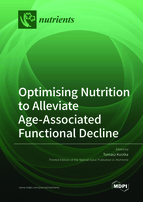Optimising Nutrition to Alleviate Age-Associated Functional Decline
A special issue of Nutrients (ISSN 2072-6643). This special issue belongs to the section "Clinical Nutrition".
Deadline for manuscript submissions: closed (1 January 2021) | Viewed by 42571
Special Issue Editor
Interests: older people; nutrition; nutritional status; functional decline; muscle function; quality of life
Special Issues, Collections and Topics in MDPI journals
Special Issue Information
Dear Colleagues,
Nutrition and physical activity are cornerstones of preventive gerontology. Nutritional status changes with advancing age. In younger seniors, typical problems usually include overweight/obesity, hyperlipidemia and hyperglicemia. Prevention and treatment are focused on cardiometabolic disorders. In older seniors, problems of protein–energy malnutrition, sarcopenia and frailty become dominant. Research in recent years has provided us with new data and scientific approaches on how to drive nutritional behaviours to prevent cardiometabolic disorders on the one hand, and to foster the intrinsic capacity to alleviate age-associated fumctional decline on the other. With this Special Issue of Nutrients, we hope to gather new data on nutritional recommendations in seniors of different ages, functional statuses and comorbidities. We welcome the submission of different types of manuscripts, including original research articles and up-to-date reviews (systematic reviews and meta-analyses).
Prof. Tomasz Kostka
Guest Editor
Manuscript Submission Information
Manuscripts should be submitted online at www.mdpi.com by registering and logging in to this website. Once you are registered, click here to go to the submission form. Manuscripts can be submitted until the deadline. All submissions that pass pre-check are peer-reviewed. Accepted papers will be published continuously in the journal (as soon as accepted) and will be listed together on the special issue website. Research articles, review articles as well as short communications are invited. For planned papers, a title and short abstract (about 100 words) can be sent to the Editorial Office for announcement on this website.
Submitted manuscripts should not have been published previously, nor be under consideration for publication elsewhere (except conference proceedings papers). All manuscripts are thoroughly refereed through a single-blind peer-review process. A guide for authors and other relevant information for submission of manuscripts is available on the Instructions for Authors page. Nutrients is an international peer-reviewed open access semimonthly journal published by MDPI.
Please visit the Instructions for Authors page before submitting a manuscript. The Article Processing Charge (APC) for publication in this open access journal is 2900 CHF (Swiss Francs). Submitted papers should be well formatted and use good English. Authors may use MDPI's English editing service prior to publication or during author revisions.
Keywords
- overweight
- obesity
- malnutrition
- nutritional status
- functional status
- physical activity
- intrinsic capacity
- sarcopenia
- frailty
- elderly
- disability







